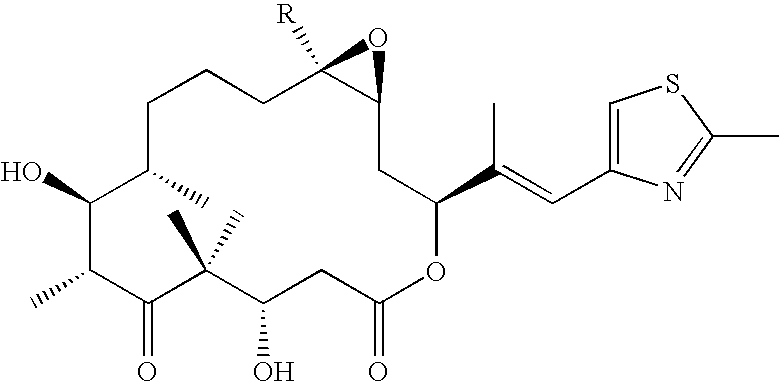Process for the isolation and purification of epothilones
a technology of epothilone and purification process, which is applied in the field of process for the isolation and purification of epothilone, can solve the problems of increasing affecting the efficiency of epothilone, so as to reduce the consumption of mobile phase and increase productivity
- Summary
- Abstract
- Description
- Claims
- Application Information
AI Technical Summary
Benefits of technology
Problems solved by technology
Method used
Image
Examples
example 1
Work-up Procedure for Epothilone B
[0053]Desorption of 591.7 kg of charged resin (styrene / divinylbenzene copolymer resin XAD-16 charged with epothilones A and B from a culture medium) is effected by stirring the resin in two portions each with 720 liters of toluene in four portions for appr. 8 hours. Separation of the toluene phase from the resin takes place using a suction filter. The combined toluene phases are washed in two portions with each 250 l of water. After phase separation, the toluene extract is concentrated in a 1000 liters reactor to approximately 20-40 liters and afterwards concentrated to dryness in a rotary evaporator under vacuum. The result is a toluene extract of 4.095 kg containing 209 g of epothilone B. The toluene extract is dissolved in 16.5 liters of methanol and 24.5 liters of cyclohexane. After addition of 0.8 liters of water phase separation occurs immediately. The methanol fraction is evaporated to dryness in a rotary evaporator under vacuum yielding 1.02...
example 2
Comparison of Different Desorption Processes for Epothilone B Preparation
[0057]360 ml each of an aqueous suspension of the styrene / divinylbenzene copolymer resin XAD-16 charged with epothilone A and B from a culture of myxobacteria by the method described in WO 99 / 42602 (corresponding to 194 g wet Amberlite® XAD-16) are extracted with the solvents and under the conditions mentioned in the subsequent table in a stirred (common lab anchor stirrer) glas reactor with a sintered frit at the bottom (home made solid phase batch reactor, inner diameter 10 cm×20 cm lengths, “Stirrer / Frit” hereinafter).
[0058]
TABLE 1Comparison of Desorption methods for the manufacture of Epothilone BStarting resin (resin with absorbed epothilone):#1001 theoretical load 70 mg per 360 ml resin suspension(corresponds to 70 mg per 194 g of wet XAD-16)#1003 theoretical load 114 mg per 360 ml resin suspension(corresponds to 114 mg per 194 g of wet XAD-16)
[0059]
Variant123456ReactorStirrer / Frit (RT)Stirrer / Frit (RT)St...
PUM
| Property | Measurement | Unit |
|---|---|---|
| flow rate | aaaaa | aaaaa |
| retention time | aaaaa | aaaaa |
| weight | aaaaa | aaaaa |
Abstract
Description
Claims
Application Information
 Login to View More
Login to View More - R&D
- Intellectual Property
- Life Sciences
- Materials
- Tech Scout
- Unparalleled Data Quality
- Higher Quality Content
- 60% Fewer Hallucinations
Browse by: Latest US Patents, China's latest patents, Technical Efficacy Thesaurus, Application Domain, Technology Topic, Popular Technical Reports.
© 2025 PatSnap. All rights reserved.Legal|Privacy policy|Modern Slavery Act Transparency Statement|Sitemap|About US| Contact US: help@patsnap.com

